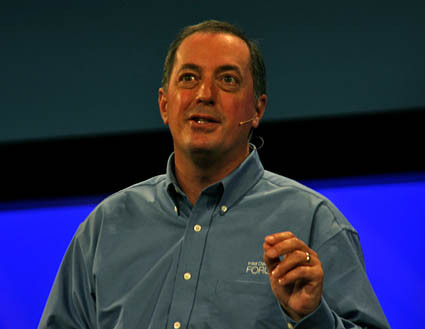Intel CEO announces Core 2 Quad
San Francisco (CA) - It wasn't much of a surprise anymore, but at least its official now: Intel will ship the first quad-core enthusiast processors as well as 2-way quad-core processors in November. The first mainstream quad-core will be introduced in Q1 of next year under the "Core 2 Quad" brand.
Chief executive Paul Otellini delivered on the widely expected news of Intel's first quad-core processor in his opening keynote of the Fall Intel Developer Forum (IDF). The new processor, which will be named Core Extreme QX6700, will provide a 70% performance improvement over today's Core 2 Extreme CPU, according to Intel. That claim is about in line with recent findings published by Tom's Hardware that saw the "Kentsfield" chip to perform substantially better than the dual-core Core 2 Extreme X6700, however, at significantly higher power levels.
Otellini said that the first quad-core is specifically aimed at gamers and content creators, which not only indicates a verylimited availability but also the usual high tray price ($1000) of the Extreme processor series. Intel will follow up with a quad-core mainstream processor in Q1 of next year. The "Core 2 Quad" will support Intel's revenue of the Core 2 processor series on the higher-end mainstream.
For servers, Intel is expected to introduce the Xeon 5300 quad-core series (codename "Clovertown") in November and offer a lower-power version in the first quarter of next year. The "L5310" will aim for integration in blade servers and drop the thermal design power rating of the 53100 series from 80 and 120 watts to 50 watts.
Intel CEO Paul Otellini
According to Otellini, quad-core processors will be "extremely" important in data processing servers and "very" important for high-end desktops in the near future - at least in systems "where image is everything". Otellini briefly responded to concerns that Intel's first quad-core packages are simply "glued-together" dual-core processors while AMD is working on a native, single-die quad-core chip. "So what?," said Otellini, adding, "The public doesn't care what's inside a processor."
Intel also provided an outlook into the 45 nm processor generation, which is on track to go into production in the second half of 2007. According to Otellini, Intel currently has 15 different 45 nm chips already in development. The new products include the successor of the current mobile Core 2 Duo processor with Merom core that is currently known as "Nehalem". Nehalem is scheduled to be released in 2008 as a 45 nm shrink. Senior vice president David Perlmutter told TG Daily in an earlier interview that power/performance aspects as well as basic and integer/floating point performances will increase "dramatically." In 2010, Intel plans to unveil the first mobile 32 nm processor called "Gesher."
Get Tom's Hardware's best news and in-depth reviews, straight to your inbox.
Other 45 nm processors will include the processors Wolfdale (dual-core, 2008), Ridgefield (dual-core, 2008), Bloomfield (quad-core, 2008) and Yorkfield (eight-core, 2009) for the desktop.
While the new processors are expected to provide much more performance than today's processors, Otellini mentioned that Intel keeps its focus on power efficiency: "By the end of the decade we will deliver a 300 percent increase in performance per watt over today's processors," he said.
The traditional outlook into the future included a 300 mm2 processor die that integrates 80 floating point processing cores, which are capable of achieving a performance of 1 Teraflops - about 40 times the floating point speed of a current Core 2 Duo chip. According to Otellini, a similar capability required 10,000 Pentium Pro processors 11 years ago.
During a Q&A session following the keynote, the chief executive reiterated Intel's goal to claim the market leadership in power efficient computing from AMD. However, he said "perception of the market does not change overnight. It moves in bits and pieces."
More news from the Fall Intel Developer Forum:
Multi-core processors may replace physics cards, says Intel
First quad-core workstation, server announced

